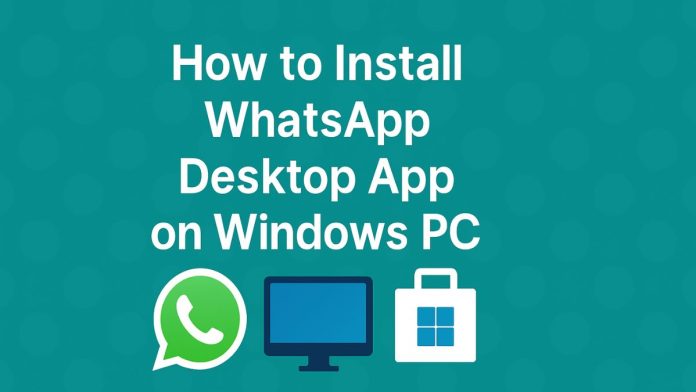WhatsApp is one of the most popular instant messaging platforms globally, with billions of users who rely on it for daily communication—both personal and professional. While originally developed as a mobile-first application, WhatsApp has expanded its capabilities to include desktop and web access, offering users a seamless experience across multiple devices. For individuals who spend considerable time on their PCs—whether for work, study, or entertainment—the WhatsApp Desktop app becomes a highly convenient tool, eliminating the need to constantly pick up their smartphones to send or read messages.
This comprehensive guide will walk you through every step necessary to install the WhatsApp Desktop application on a Windows PC. Whether you’re a beginner using Windows for the first time or a seasoned tech user wanting a step-by-step refresh, this article ensures you’ll have everything you need. Along the way, we’ll also cover WhatsApp Web, system requirements, troubleshooting tips, and security best practices.
Understanding WhatsApp Desktop vs. WhatsApp Web
Before diving into the installation process, it’s important to understand the difference between WhatsApp Desktop and WhatsApp Web.
WhatsApp Web
- Runs entirely in a browser (e.g., Chrome, Firefox, Edge)
- Requires no installation
- Great for occasional use
WhatsApp Desktop
- A standalone app for Windows or macOS
- Better performance
- Native notifications
- Faster startup
- More robust and secure
For users who frequently use WhatsApp alongside their PC tasks (such as business communication, media sharing, or customer service), the desktop app is strongly recommended over the web version.
How to Install WhatsApp Desktop App – Two Methods
There are two primary methods to install WhatsApp Desktop on a Windows PC:
Method 1: Install via Microsoft Store (Recommended)
- Open the Microsoft Store:
- Press the Windows key, then type Microsoft Store, and press Enter to launch it.
- Search for WhatsApp:
- In the search bar at the top, type “WhatsApp Desktop” and hit Enter.
- Select the Official App:
- Click on the result that says WhatsApp Desktop by WhatsApp Inc. (Verify it’s not a third-party imitation.)
- Click “Get” or “Install”:
- The button label may vary depending on your system, but clicking it will begin the download and installation automatically.
- Wait for Installation to Complete:
- Once done, click Launch to open the app.
- Link Your Phone:
- A QR code will be displayed. Use your phone to scan it (see Section 4 for instructions).
- Start Messaging:
- All your chats will sync with the desktop app, and you’re ready to use WhatsApp from your PC.
Method 2: Install via WhatsApp Official Website
If your Microsoft Store isn’t working or you prefer downloading the executable installer, this method works well.
- Visit the Official Website:
- Click “Download for Windows”:
- The website automatically detects your OS and suggests the correct file.
- Download the Installer (.exe):
- Save the file to your Downloads folder or Desktop for easy access.
- Run the Installer:
- Double-click the downloaded
.exefile. - Windows might ask for permission—click Yes to continue.
- Double-click the downloaded
- Installation Progress:
- The installer will copy necessary files and create desktop/start menu shortcuts.
- Launch WhatsApp:
- After installation, the app launches automatically.
- You can also open it later from the Start menu or desktop shortcut.
- Link with Phone:
- A QR code will appear. Use your mobile WhatsApp app to scan and link (instructions in the next section).
Linking WhatsApp Desktop with Your Mobile Device
To use WhatsApp on your PC, you must link it to your phone. Here’s how:
On Android:
- Open WhatsApp.
- Tap the three-dot menu (top right) > Linked Devices.
- Tap Link a Device.
- Authenticate with your fingerprint or PIN.
- Scan the QR code on your desktop app.
On iPhone:
- Open WhatsApp.
- Tap Settings (bottom right) > Linked Devices.
- Tap Link a Device.
- Use Face ID/Touch ID or passcode if prompted.
- Scan the QR code on your PC screen.
Within seconds, your chats and messages will sync with the desktop version.
Features of WhatsApp Desktop
WhatsApp Desktop offers many of the same features as the mobile app, such as:
- Sending and receiving text messages
- Sharing files, images, videos, and documents
- Voice messaging
- End-to-end encryption
- Desktop notifications
- Dark mode
- Group chats and broadcast lists
- Synchronization with mobile messages
However, note that some mobile-exclusive features—such as voice/video calling—were initially missing but have now been added in newer versions. Make sure your desktop app is up to date.
Alternatives – WhatsApp Web
If you prefer not to install the desktop app, WhatsApp Web is a good alternative.
How to use WhatsApp Web:
- Open your browser and go to https://web.whatsapp.com
- A QR code will appear.
- Use your phone to scan and link the device.
- Chats appear and work similar to the desktop app.
Limitations of WhatsApp Web:
- Relies entirely on your browser session
- Slower than the desktop app
- No system-level notifications unless allowed
- Requires your phone to stay connected (though multi-device support is improving this)
Conclusion
Installing the WhatsApp Desktop application on a Windows PC is a simple yet powerful way to enhance your communication workflow. Whether you’re working from home, attending classes, or managing a business, having WhatsApp directly on your computer saves time and boosts productivity. With this detailed guide, you should now have all the tools and information necessary to install, configure, and troubleshoot WhatsApp Desktop successfully.
By following the steps above and adhering to best practices, you’ll enjoy a seamless, secure, and efficient messaging experience on your Windows device.


![How to Use WhatsApp Web? [Beginners Friendly] how-to-use-whatsapp-web-thumb](https://www.internetoutsider.com/wp-content/uploads/2025/05/how-to-use-whatsapp-web-thumb-218x150.jpg)




